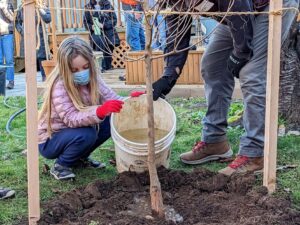Tag: leaflet
A Leaflet on Leaflets
If you’ve ever gone on a tree walk with Eugene Director Erik Burke, you’ve heard about some of the nuanced differences among trees that you can study to identify them. One iconic characteristic is always a good starting point: the leaf. Summer is a great time to investigate the myriad shapes that leaves take.

But what exactly comprises a single leaf? A tricky aspect of plant morphology is understanding simple leaves versus compound leaves. A simple leaf is a singular leaf connected by its stem, or petiole, to the branch (like the Oregon white Oak pictured above).
Sometimes what you might think is an entire leaf is actually a leaflet on a compound leaf. Leaflets will all be attached to the main petiole, which is connected to the branch. How can you tell the difference? Look for the bud node, which will appear where the stem connects to the branch, but not where a leaflet connects to the stem.
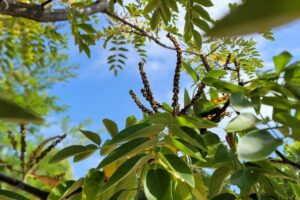
Some compound-leaved trees include golden rain tree, red horsechestnut, yellowwood, Amur maackia (pictured above), and Kentucky coffee tree (pictured below). The Kentucky coffee tree has double compound leaves. That means that their leaflets have leaflets. Their leaflet branches can have 40 leaflets!
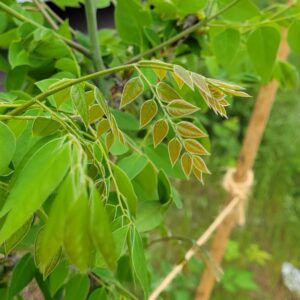
Some other common trees that folks may know that have compound leaves include ashes, buckeyes, locusts, walnuts, and the infamous tree of heaven. Becca and Erik in the Eugene office sometimes compete at events for who can find the tree of heaven leaf with the most leaflets. Becca currently has the record with 49.
One of the best times to get up close and personal with a tree’s leaves is when you’re pruning. Our Eugene-Springfield team is hosting community printing events August through October. Details here.
Leaflet – Watching the Seasons Change

You’re not the only one who’s noticing that the days are getting shorter. Our trees are noticing, too, and they’re taking it as a sign that the growing season is over. How do they notice? A hormone response is triggered by the shorter daylight hours, the angle of the sun, the cooler temps. This past month, you may have noticed a spring-like flush of herbaceous growth on your trees—one final push before autumn. That new growth will harden into woody material tough enough to survive our first frost in November.
Leaves on some deciduous trees will start changing color, a welcome sign of the cooler seasons after an especially hot summer. In a process called abscission, trees reabsorb the nutrients stored in the leaves before detaching and shedding them. Chlorophyll, which gives leaves their green color, is one of the first things to be absorbed, which is why we see them change color. But fallen leaves still have plenty of nutrients, which is why we encourage you to leave the leaves. Trees are putting those leaves there on purpose, to enrich the soil for their roots.
Most deciduous trees shed leaves in the fall. Some don’t though! Scarlet oaks, swamp white oaks, and many evergreens shed leaves in the spring as new growth emerges
For now, the best thing we can do is watch the weather, just like our trees are. Continue your watering regime until we’ve had one inch of rain in a week. After that, we’ll be out of the dry season and beyond the growing season when trees actively expand their canopies as they photosynthesize. And it happens to coincide with the timing for our trees to transition into winter dormancy, when their sap returns to their roots.
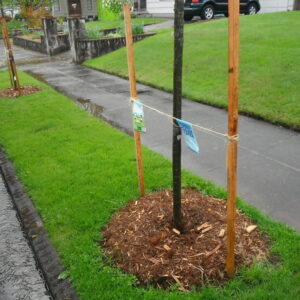
Roots can grow year round in the right conditions—moisture, air, and temperature—which is why we plant when we do, so trees can focus on establishing their roots. To help keep those conditions right for your young tree, make sure you replenish your mulch in the next couple months. One inch of mulch is a windbreaker, three inches is like a down jacket – and we want that year round, protecting against temperature extremes. Tree roots can grow 365 days a year as long as they have some moisture and a moderate soil temperature, both things that mulch provide.
This time of transition can be really exciting. It’s always remarkable to feel like summer is barely over, but by Halloween, which is now right around the corner, most of our trees will be dormant. As the seasons change, so do the needs of our young trees. So watch the weather, and stay tuned to Treemail for best practices for each season!
Leaflet
Restoring the Balance
Today, we’re asking you to put yourself in a tree’s shoes–or roots. Planting day is so exciting for volunteers. We get to hang out with our neighbors, get our hands dirty, and feel good about getting trees in the ground. But planting day is the most stressful day of a tree’s life.
When we plant a tree, we have to cut some of its roots. Container-grown trees need to have their roots cut to prevent them from circling in on themselves, even after they’re put in the ground. Ball and burlap trees are grown in the ground, but they also get their roots cut when they are put into that ball to be moved to their final location.
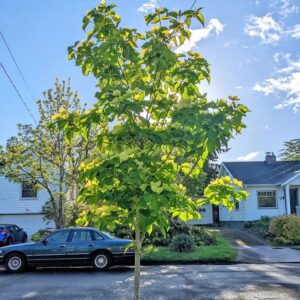
Trees are all about balance. Balance between canopy, where the tree can feed on sunlight and perform photosynthesis, and roots, which pull nutrients from the soil and provide the tree its needed strength and stability. For a newly planted tree, this time of year is all about restoring that balance and getting the roots and the shoots established.
Trees are like icebergs—there’s a lot more going on beneath the surface than we realize. Being able to understand what’s going on underground for our trees helps us better care for them, especially when it comes to watering.
We’ve mentioned watering plenty, but it’s so important that we can’t really talk about it too much. We have had an incredibly wet spring, which is great for the trees! As stewards, we’ve been able to keep our foot off the gas—we haven’t really had to worry about getting out our hose or watering bucket all that much.
But at some point the rain becomes intermittent and shallow enough that it doesn’t reach the tree roots. Watering trees is very different from watering grass, which benefits from frequent and shallow watering. One of the most common watering mistakes is watering your tree like you would your grass, for just a few minutes every day. For trees, we want deep and infrequent. In the summer, a thorough watering once a week is a perfect schedule (see details here).
When you water your tree, imagine what’s going on underground. We want to water the tips of the roots as they spread out. Another common watering mistake is when folks just point their hose at the base of the trunk and water there. You want to simulate a rain storm for your tree, watering all sides, and several feet away from the trunk so that you get the tips of the roots.
Overwatering is rare, but you still want to avoid it. Again, it helps to picture what’s going on beneath the surface. Perfect soil is about 50% air and water pockets. Too much water can flatten those pockets and there’s no air. You’re essentially drowning your roots. Beyond that, too wet soil threatens the stability of the tree. When a tree fails because it’s thrown by the wind, it’s usually because the soil is too wet.
This time of year, we are spectacularly rewarded for our care for our trees. Bud break, flowering, leafing out—it’s a rejuvenating thing to see each spring.
If you’re thinking about getting a new tree for your yard next year, now is a good time to consider which species you might want! What trees are catching your eye? What looks like it might be right at home in your yard. Take note now, and next year, we can get you what you’re looking for!

